| Article ID | Journal | Published Year | Pages | File Type |
|---|---|---|---|---|
| 4480036 | Agricultural Water Management | 2007 | 14 Pages |
Reuse of saline-sodic drainage water (DW) to irrigate salt-tolerant forages is an attractive option for growers in California's drainage-impaired, San Joaquin Valley since it will reduce the volume of drainage water requiring disposal and supply feed to expanding dairy and beef cattle industries. Five forages (tall wheatgrass, paspalum, creeping wildrye, bermudagrass and alfalfa) were evaluated in a greenhouse study to compare forage species for biomass yield, mineral composition, and quality as ruminant feeds when irrigated with freshwater (ECw = 0.85 dS/m) and saline DW (ECw = 11 and 18 dS/m) and grown in a field soil mix characteristic of the drainage-impaired areas. Tall wheatgrass was highly salt-tolerant with a relative yield of 85% under high salinity, whereas the relative yield of alfalfa was 43%. Metabolizable energy (ME in MJ/kg DM), the potential energy that the ruminant can obtain from consuming the forage, was higher in this greenhouse study as compared to our prior field study (Suyama et al., 2006). ME differed among the forage species and was ranked as: tall wheatgrass and alfalfa > paspalum > bermudagrass and creeping wildrye. All forages were deemed suitable as feeds for beef cattle and goats fed at maintenance energy levels. However, with long term consumption, the high selenium and sulfur content of these forages could potentially affect animal physiology, unless they were fed in a mixed ration.
